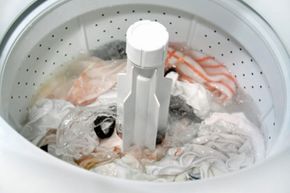Washing clothes has been a big chore since man first discovered the value of whacking garments on rocks in nearby streambeds to get them clean. There was plenty of water back then, but the labor was backbreaking. Modern washing machines save on labor and time over the old rock or washboard methods, but energy and water usage issues are putting them in the line of fire from environmentalists and cautious consumers.
It's hard to look at water usage for washing machines without looking at the issue of energy usage, too. Washers soak clothes, tumble or agitate them and then extract as much water as possible to promote fast, efficient drying. From a water usage standpoint, it's a matter of employing as little of the wet stuff as possible at the beginning of the process -- to wash the clothes -- and then getting rid of as much water as possible from the newly cleaned clothes to make drying them an energy-efficient process.
Advertisement
The washing machine style you're probably most familiar with is the top-loader. A conventional top-load washing machine uses agitation to clean clothes. It's been the standard for decades. The concept of agitation has a long history that goes back to manual paddle mechanisms that worked a little like handheld egg beaters to churn the dirt off of clothing. For agitators to work well, though, they need lots of water to toss, whip and stir clothes around. That water can get expensive, and the energy necessary to heat it can get expensive, too. Around 90 percent of the energy necessary to clean a load of laundry in a top-load washer is used to heat the water.
Newer clothes cleaning strategies lose the agitator altogether. This allows more room for dirty clothes in a load while still lowering the water requirement. Other refinements in the process also mean less water left in the finished batch of laundry, which translates to less water for the drying process to remove. That's good news all around. What's the magic machine that saves water and energy while allowing you to wash more clothes per load? That would be the front-loading washing machine.
No washing machine style is perfect, but front-loaders have a lot going for them, especially from a water management standpoint. On the next page, let's look at a few water facts as they relate to top-load and front-load washing machines. No spin here, just the facts.
Advertisement
